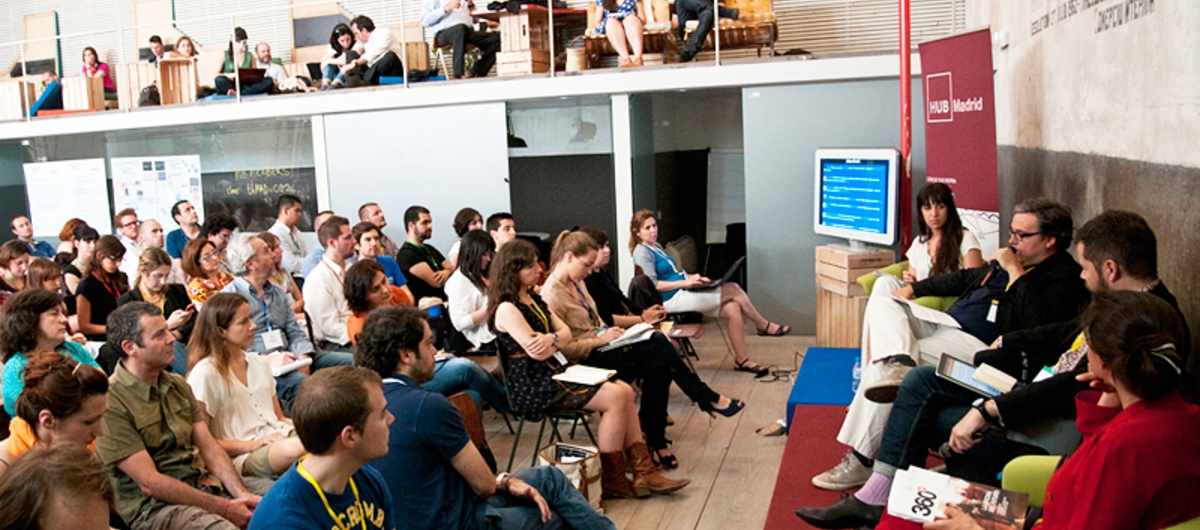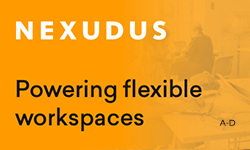There is no doubt that coworking is changing the way we work. But we shouldn’t delude ourselves: we’re not reinventing the wheel. On the contrary, these ‘new’ structures are revisiting traditional ways of working that were observed before the industrial revolution. Work and life are no longer isolated parts of our lives. The boundaries of well-defined professions are beginning to blur. Professions are being reinvented and invented anew.
On the first day of the Coworking Spain Conference, a panel was dedicated to this topic, with architect of the Hub Madrid José Maria Churtichaga, Steelcase furniture’s Serena Borghero and Coworking Building prizewinner Sara Ouass sharing their perspectives on new workspace design.
Creating density for interaction
One of the first point raised was by Churtichaga about how to create an adaptable atmosphere, one of the challenges he faced when designing Hub Madrid. “It was about creating an atmosphere that would create the greatest quantity and density of events,” he said. Coworking space operators often speak of interconnections, putting people in contact and filtering information. The space should be a catalyst for these occurrences.
This requires a cultural shift. Entrepreneurs in particular must accept the unknown as part of their work, even as a motivation, and in turn should actively reject the belief that sharing an idea is asking for it to be stolen. If coworking has taught us anything, it is that collaboration multiplies positive results.
Coworking though isn’t only for entrepreneurs. It’s represents a sustainable and ecologic way to work; the future of work. More and more companies will allow their employees to choose their workplace, including coworking spaces. Employees will be presented with the choice of where, to work, when, with whom, and within which community. And, taking into account these factors, the challenge is clear: how best design a space that represents the future of work?
Five principles of designing a coworking space
During the panel, Serena Borghero spoke about considering five principles when carrying out a coworking space design project: maximizing surface, increasing collaboration between people, retaining talent within the space, improving the well being for the users and brand development.
Simple practices should be observed. Long corridors for example, often found in traditional corporations, make communication between people difficult - and so should be avoided. Likewise, incorporating furniture that brings people together while simultaneously respecting their work environment or private areas are basic pillars in coworking space design.
Consider cultural differences
Two extra factors should also determine the design. First, the space location. Recognizing the difference between being located in the centre of a large city (like Hub Madrid, for instance), is different than a space located outside the city, close to an airport, or in a small town.
Second, cultural particularities are crucial to design. In countries such as The Netherlands, the coworking movement has grown and developed faster, partly thanks to the Dutch culture. The Netherlands are typified by almost no hierarchies at work, flat structure organizations, and a culture that considers each individual responsible for their tasks, as long as they are delivered on time.
This is vastly different from Spanish and Italian work cultures. In a coworking space in The Netherlands, the manager’s desk is no different from the rest. In Spain and Italy, the operator’s desk is more often than not distinguishable.
Concepts of privacy and proximity are also different. Spaniards and Italians tend to speak louder, are more tactile, and are thus more able to work side by side. The ‘necessary’ distance between people is proportionately smaller than in other cultures.
This is the case for traditional work environments, where colleagues are working on the same projects. However, these cultural values means that coworking is often (at first) considered a strange concept. Manuel Zea from Coworking Spain recalled how difficult it was to implement these principles in his first coworking space in Madrid. “People called us to ask about renting a space, and couldn’t understand what we were talking about. ‘Don’t you have isolated offices? Open spaces?'
Allowing the unexpected to happen
While it’s true that Spanish culture is changing and the interest in joining a coworking space is increasing, the coworking movement had to start from scratch. That is, the benefits of sharing and being a part of a professional community spirit needed first to be explained.
“Unexpected events must happen at coworking spaces, they must be open to change and therefore, they must be imperfect, unfinished”, explained José Maria Churtichaga. “The experience should usually be exciting”. Comfort can breed laziness. A margin of discomfort can motivate us to push ourselves, to interact, and to leave our carefully-constructed comfort zones. And this is really the crux of the coworking experience.
:::
This article is introducing our new writer from Madrid: Marta Santacana.








